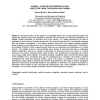Free Online Productivity Tools
i2Speak
i2Symbol
i2OCR
iTex2Img
iWeb2Print
iWeb2Shot
i2Type
iPdf2Split
iPdf2Merge
i2Bopomofo
i2Arabic
i2Style
i2Image
i2PDF
iLatex2Rtf
Sci2ools
CVHI
2007
2007
SUBPAL: A Device for Reading Aloud Subtitles from Television and Cinema
: The primary focus of this paper is accessibility barriers for visually impaired people and people with dyslexia. Due to their disability a segment of these people have limited accessibility to the subtitle content presented on television and in the cinema. It is utterly important to be able to participate in such social and cultural events, but if the material presented is in a non familiar language they are unable to understand it. The problem primarily arises from non English speaking countries where dubbing is not facilitated such as in Scandinavian countries and the Netherlands. A solution to this problem is SubPal, a text to speech device which can be connected to the television or to a video camera. The subtitle content in the presented video stream is read aloud through a multilingual speech synthesizer. Hence the solution is applicable for television and in the cinema, in several countries. The solution comprises three major modules: The sampling of the analogue video signal ...
CVHI 2007 | Emerging Technology | Optical Character Recognition | Speech Synthesizer | Subtitle Content |
| Added | 29 Oct 2010 |
| Updated | 29 Oct 2010 |
| Type | Conference |
| Year | 2007 |
| Where | CVHI |
| Authors | Simon Nielsen, Hans-Heinrich Bothe |
Comments (0)

